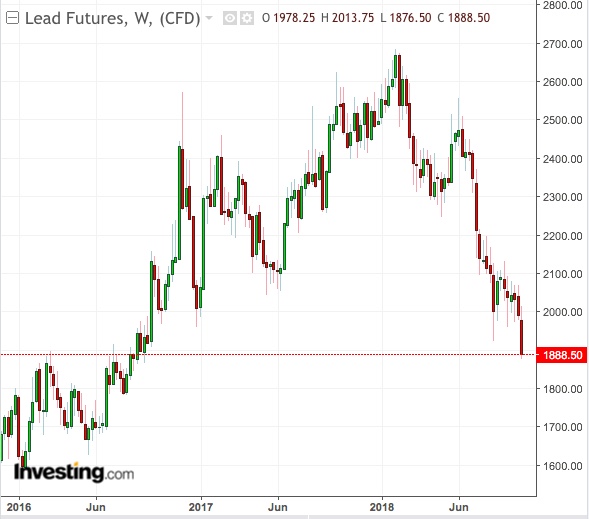It’s one of the most toxic metals known to man. And investors who took positive bets on lead this year are now feeling its poisonous effects on their portfolios.
Down 26 percent this year on worries over demand from China—its top market, currently writhing from what could also be described as a noxious trade war with the United States—UK-traded lead is at the bottom of Investing.com’s performance table for 34 commodities.
“Lead has been among the worst performing metals year-to-date, even though inventories are falling and mine supply is tight,” Bank of America-Merrill Lynch said in a note this week that put lead on the 18th spot among 21 base metals.
Weak Start In China
The US investment bank said that while China’s weak start for lead demand this year has resulted in headwinds for the metal, mine supplies were still not abundant and production of refined lead was down 4.0 percent both year-on-year and year-to-date. The BofAML note said:
“China's refined lead inventories have been falling, which has kept the import arbitrage for refined metal open...Taken together, these dynamics should increasingly support quotations after the recent correction.”
At Wednesday’s settlement, three-month lead futures on the London Metal Exchange were at $1,911.50 a tonne, down from the 2017 close of $2.,496. Investing.com’s daily technical outlook has a “Strong Sell” recommendation, with Fibonacci Level 3 support—the strongest—set as low as $1,876.67, meaning there was potential for the metal to lose another $35, or nearly 2 percent, before a rebound.
First Year of Loss In Three
It wasn’t always like this for lead. In fact, this is the first year in three that it has experienced such phenomenal losses. The metal posted a 24 percent gain in 2017 and a 13 percent climb the year before.

Despite its toxic hazard, lead is widely used in making car batteries, pigments for paints, ammunition, cable sheathing, weights for lifting, weight belts for diving, lead crystal glass, radiation protection and some solders. It is also often used to store corrosive liquids.
China has long been a key driver for rising lead consumption, thanks to its population of electric bicycles, the largest in the world.
E-Bikes In Slower Lane
But sales of e-bikes have slowed this year, depressing demand for lead. With about $260 billion of goods traded between China and the US, the worsening trade tariffs war between the two countries since the first quarter has added to the pressure.
Consequently, BofaML said the lead market in China could turn into a surplus by next year, leaving more supply around to weigh on prices.
But that’s also one side of the equation, says the investment bank. The other side of the story, it says, is the acute reduction of lead stockpiles on the Shanghai Futures Exchange (ShFE) this year—a development overshadowed by the drop in e-bike sales and the US-Sino trade war.
Prices Low Despite Critically-Low Warehouse Stocks
In a special environmental coverage on September 13, Reuters reported that China’s lead stockpiles have dropped to a “critical” level as a result of environmental inspections that have shut smelters, even as demand for the metal from battery makers remains robust.
Lead stockpiles in China published by the ShFE were 29,850 tonnes on September 8 and have plunged more than 64 percent from a three-year high of 83,622 tonnes on May 19, according to the report.
Even more drastic, it said, was the supply of on-warrant lead, or metal not earmarked for delivery and available for trade. Those inventories stood at 9,735 tonnes on September 12, down from 80,089 tonnes on May 17.
